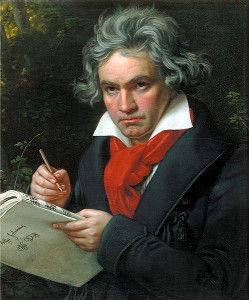Beethoven, Septet Op. 20 (Scherzo)
 We talked last week about some of the ways Chopin’s Scherzo No. 2 did not conform to what one might expect of a scherzo (literally defined as a joke or jest). Beethoven was not the first to place scherzi in his multi-movement works, but he is credited with taking the form in new directions and using it extensively. So let’s back up and look at a Beethoven scherzo. Keep in mind that Beethoven pushed the limits in many respects, including expanding musical forms, so it can be difficult to call a particular work “typical.”
We talked last week about some of the ways Chopin’s Scherzo No. 2 did not conform to what one might expect of a scherzo (literally defined as a joke or jest). Beethoven was not the first to place scherzi in his multi-movement works, but he is credited with taking the form in new directions and using it extensively. So let’s back up and look at a Beethoven scherzo. Keep in mind that Beethoven pushed the limits in many respects, including expanding musical forms, so it can be difficult to call a particular work “typical.”
That said, this scherzo from Beethoven’s Septet, Op. 20, offers a good example. The idea of a joke or jest seems like an apt description. The tempo (vivace) and meter (three-four) fit the standard mold. It revels in little surprises and sudden changes of texture.
Beethoven used the scherzo as a replacement for the minuet that often appeared in multi-movement Classical works. This scherzo has a form similar to the minuet. In its standard form, the first section was binary: a two-part structure in which each section is repeated (A – A – B – B). Here the second part (B) is longer and includes a return to the main them of A.
A trio would follow, usually in a more lyrical form. The trio would be in the same binary form (A – A – B – B). Then the first section would return without the repeats (A – B). The overall form was thus ternary: main section – trio – main section.
It’s not hard to follow. You can use these timings.
- Part I
- A (0:04 – 0:12)
- A repeated (0:12 – 9:19)
- B (0:19 – 0:49) (the A theme returns at 0:34)
- B repeated (0:49 – 1:20)
- Trio
- A (1:21 – 1:30)
- A repeated (1:30 – 1:40)
- B (1:41 – 2:00) (the trio’s A theme returns at 1:51)
- B repeated (2:01 – 2:21)
- Part I
- A (2:22 – 2:30)
- B (2:30 – 3:01)
You will find this form commonly used for minuets and scherzi through the Classical period. This is one of Beethoven’s early works when he wrote in more or less traditional Classical style. Beginning with his Symphony No. 3, Op. 55 (“Eroica”), Beethoven would expand the size and scope of his movements dramatically. So when you listen to a late work like the scherzo in his Symphony No. 9, for example, you may find it much more difficult to follow. Beethoven will have expanded each section, added some extra features, and taken liberties throughout. But the overall form still follows the general plan of this little movement from the Septet.



